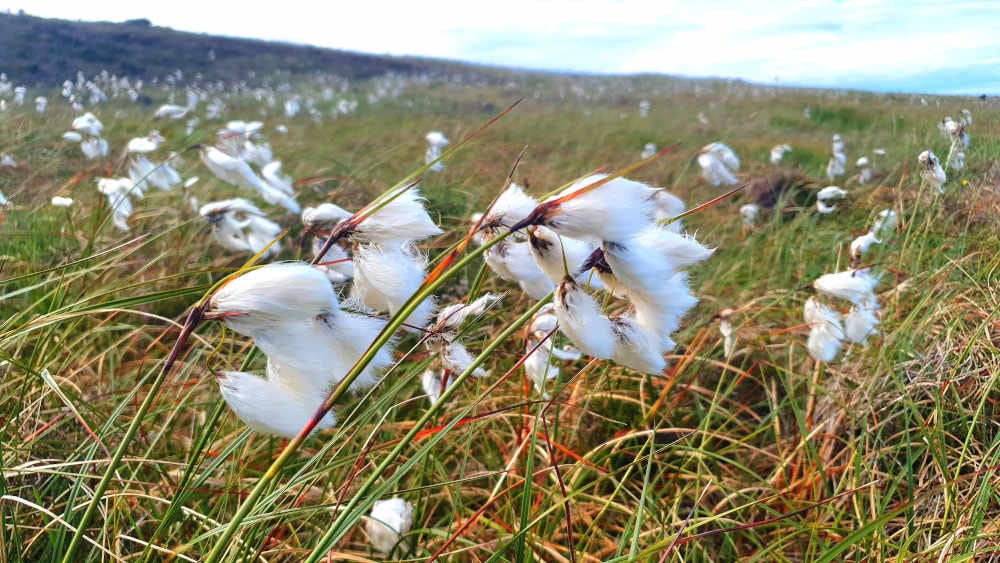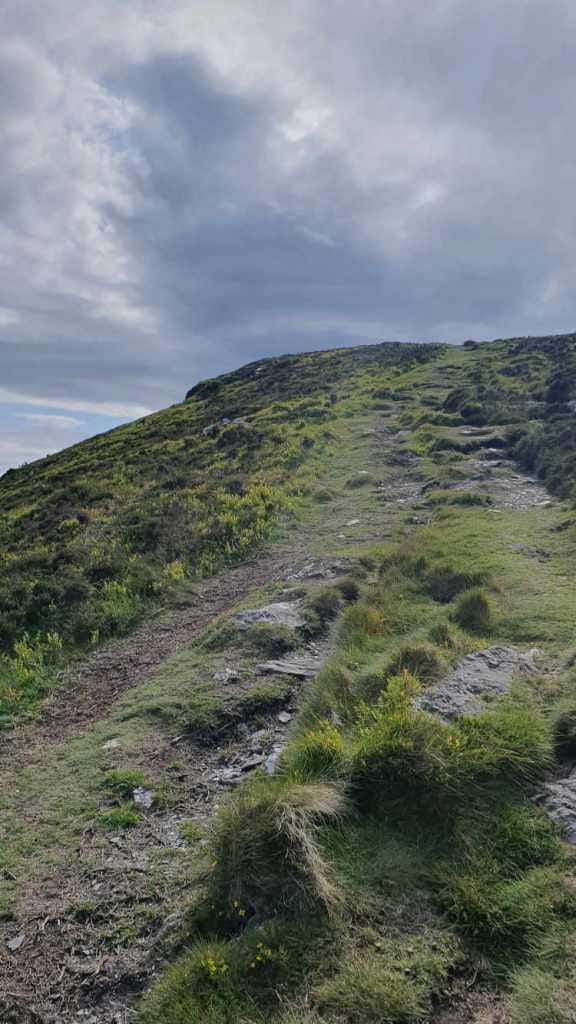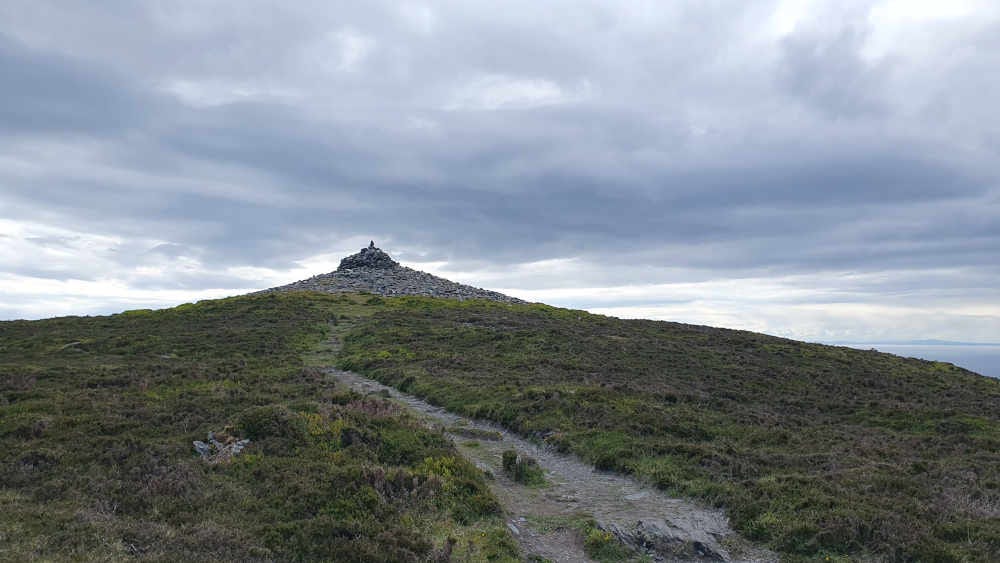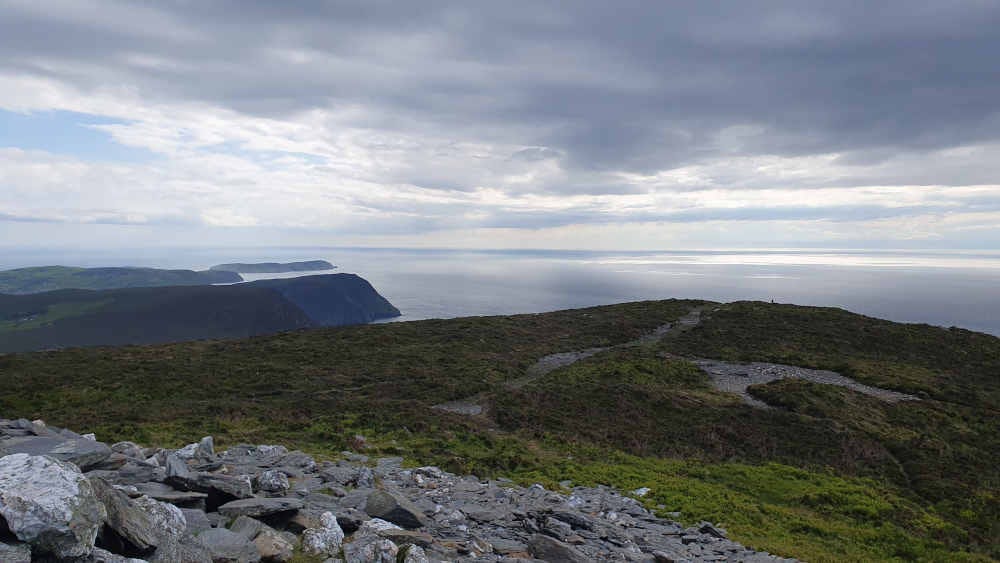Of skylarks and cottongrass
Join me in nature as we set out in search of a stunning display of cottongrass under a brooding sky.
For anyone who loves being in nature but isn’t able to get there. Leave behind the stresses and worries of daily life and join me today for another immersive walk into the natural world.
The weather has broken, but that’s okay. Sometimes the island is at its most beautiful when the churning, brooding clouds sweep in across the sea like Nature’s cloak. Today, the land is cast in a muted, diffuse light. No need for sunglasses. I can see the colours of the landscape as they truly are.
The Celtic palette has many moods – in the height of summer the egg-yolk yellows of the gorse and the regency purples of the heather help create a pageant across the hills. In winter, the ginger-snap carpet of last year’s bracken, and the charcoal skeletons of dormant trees paint a landscape robbed of saturation – but more generally, when we think of Celtic landscapes, it’s one of vigorous, impossibly varied greens; of rain-swelled mosses, and of exuberant new ferns unfurling before your eyes, of marsh grasses and clover and a patchwork of knotted heath, all set against the cold iron greys of slate and sea (both fathoms deep), and a sky that’s ready to burst. These are the colours that seem to sing to me.
They are the songs one hears on the edge of perception as you wander through a pregnant spring landscape. Songs written in languages older than any human syntax, and passed down through ages. Songs of rhythms and cycles, and of hidden processes unfolding in the soil. Songs of natural mysteries that prehistoric hands would feel compelled to evoke in their stone circles and cromlechs. Songs of water, lashing down from the sky, soaked up by the sphagnum, filtered by the peaty mulch, shared between a trillion lifeforms, before feeding into the mountain streams, passing salmon on its way back to the sea to start another verse. These songs shine through with their colours – and this palette, this visual key signature, is one that truly resonates. It forms the very expression of the wet and windy climate to which we are all accustomed to, here on the island.
But today, my family and I are in the hunt for a specific sight, and a specific colour, despite the heavy sky. We are hunting, not for green, not for grey, but for white. For just a couple of weeks a year, the high hills become veiled in what appear to be smatterings of June snow. On closer inspection, the curious walker is presented with the soft, bright fluttering of cottongrass.
As I enter the hillside through a wooden gate in a drystone wall, there are still a few patches of blue sky about us. Looking across the surrounding landscape, we see that they’re melting away by the minute. I follow the peat path that leads toward the peak of the hill. Quartz rocks lie strewn along the way. When I’ve been here at dusk, they seem to glow with an internal light of their own, stealing what luminance is left in the lagoon-blue sky to lead my way home. But even now, on this overcast afternoon, they seem incongruously bright and cheerful.
Upward this thin white line slinks, tracing its way toward the heavens. My hope is to reach the top before being rained upon. But even if I don’t get that far, I will have found what I came to see, for only a few hundred yards up, I begin to spot the first patches of cottongrass. I draw closer.
Above me, I hear the unmistakable call of a skylark. So high as to be effectively invisible, skylarks hover over their nest broadcasting the most liquid of melodies. I cast my gaze upward searching for the bird. It takes some time, but eventually I find it – the smallest, indistinct dot, undulating in that visual rhythm that can only mean wingbeats. Their call covers such a large range, they must truly be one of the loudest songbirds to be found. I listen for a while, as the skylark casts its music like a shield around its territory. The sound never fails to lift me. But perhaps this water-like melody is a portent, cascading from the clouds as it is – so I press onward while I have the chance.
A little further up, I find my quarry. All about me, fluttering in the moist breeze, are thousands of cottongrass pompoms. They wave in unison like tiny cheerleaders, rippling across the slope in a Mexican wave. I crouch down to gain a closer look. Each fluffy cloud is snagged upon a single green needle – a spine of grass that, in any other month, would blend into the background unnoticed. But not in June.
I play with a tuft, surprised by its utter softness. I can barely feel it against my skin – perhaps I am only imagining its touch. My daughters and I play a game of closing our eyes and trying to guess when the other has brushed our palm with it. I guess right only 50% of the time. This probably explains why cottongrass is harvested across Europe for pillow stuffing or wound dressings. Crouching down like this, my perspective foreshortened, it’s as if I am back in mid January, surrounded by a hillside clothed in snow. And yet, in my heart there is an up-swell, of the kind I only get when the landscape is erupting with life.
I carry along the path, walking amongst the cottongrass on either side of me. Magnificent! Somewhat upstaged, but nonetheless beautiful, I spot tormentil and eyebright nestled in the cracks between rocks. And the very first flowering sprigs of bell heather ring out their notes at a pitch between pink and purple.
The path begins to steepen now, and a million footfalls have produced, over the centuries, a stepped climb over rocky prominences, each an alpine garden. I love observing these miniature habitats. I kneel down once more, my eye to the earth, as in prayer. I grab my loupe and press the penny-sized lens to my eyelashes.
Now I can wander at leisure amongst the stonecrops, the mosses and willowherbs, exploring a world no larger than a footprint. I climb a tiny beanstalk. I sit on it’s thick, waxy leaves. I cling to it’s spiny hairs so I can safely peer down to the jungle floor below. Every once in a while, an elephantine red mite scuttles over the boulders and into a thicket, and I am thankful they are not usually this large.
A brisk gust brushes my cheek to remind me of my real size, and more importantly, of the coming rain. Time to cover the last stretch. In a month or so, the top of this hill will be covered in blaeberries – round and as juicy as blueberries, but with a tart kick. I love harvesting them with my girls, and time will surely melt away on some sunny July afternoon, as we merrily scour the landscape for the perfect scutch.
But not today. Today is about cottengrass fields, and the exhilaration of a glorious view in a high wind that must surely await us at the summit. I round the shoulder of the hill, and the tip of the cairn comes into view.
Cairns – heaps of rocks that cap hills and mountains – are among humanity’s most ancient landmarks. They are waypoints, religious sites, points of spiritual significance, all rolled into one – and, of course, that age-old human need to leave one’s mark on the world.
Shaped like a bell-curve, I start climbing the cairn before I’ve realised I’m even on it. At some point, you cross a threshold and enter the cairn’s lithiosphere. This is the moment when you look down and notice that the ground beneath your feet is more stone than earth. After that, these rocks rise upward – slowly at first – leaving the soil behind and curving, stacking upward, until you have no choice but to watch your every step, should you twist an ankle between two quartz molars.
Finally, I clamber unsteadily on hand and knee, to reach the apex and stand aloft the highest stone – a lintel-sized shard of slate that’s been propped up at a pleasing, and practical angle. I lean into it’s slope and brace myself against the wind, looking out along the coastal cliffs and away to sea. Ah! This is worth the climb. Worth whatever the elements may throw at you, summer or winter.
If I remember, I carry with me a stone up the hillside whenever I visit, as an offering to this ancient monument. A contribution and a way to connect with the countless generations that might have had a hand in maintaining this false summit. If I forget, I simply take one from the outer rim and plonk it near the top, temporarily reversing the hand of entropy, as it strains year-round to undo the cairn and level it with wind and rain.
From its peak, I can see Scotland, Wales and Ireland rising up from the hazy horizon. Sometimes they are crystal clear, with fields and individual buildings discernable. Just a stone’s throw away. Other days they disappear completely into the sea. Today, they appear as a simple, gestural brushstroke on a watercolour canvas. The merest suggestion of mountains and glens.
Looking directly along the island’s coast, I watch the cliffs that range southward along the undulating hills – a cairn on each peak. As well as being sacred, these are the lookouts for Celtic sentinels who might once have lit a fiery beacon at the first sign of trouble. I imagine them now, in the dead of night, raising the alarm, each of the other lookouts lighting up in response, to form a string of fires along the coast.
Or they may also have lit them to mark the seasons, as I have experienced myself, during the solstice torch procession near my home. Trying to light a torch from a bonfire atop of a hill in high winds is no easy feat! And if it’s gusting unpredictably, you’re likely to lose your eyebrows too. But the ferocity of hilltop fires leave an impression, not only on the retina, but in your heart. That whipping, writhing inferno convinces that you have witnessed something living – elemental and primal. A spirit of sorts; some essence or living facet of the landscape expressed in a burst of fire.
I return my attention to the present. My daughter has climbed to the top of the cairn and stands triumphant, surveying all that she sees. Her arms aloft, she strikes a pose in defiance of the fierce wind. I feel a swell of love and pride. She points to the sea away to the west and I turn to look. The surface glows with diffuse outpourings of light. Somehow, the sunshine has managed to work its way through the odd hole in the cloud. It splashes across the surface of the water like pools of milk. You could be forgiven for thinking the light was emanating from beneath the waves, such is its ghostly nature. A glimpse of some undersea mer-kingdom.
But it’s the kingdom of heaven that’s flexing its muscle now. It’s blowing a gale, and I can see the gloomy cloud banks marching inward before my eyes. Dark curtains of rain have been drawn across the water, some miles out to sea. Wafting as if in a gentle breeze, these giant veils are blowing this way at a significant rate of knots.
We have tested our luck far enough. Now is the time to turn back before we are caught in a downpour. Down the cairn we totter. My wife and youngest daughter are already some way ahead of us. But before returning back over the crest of the hill, I look back to face the oncoming weather. It may not be the deadly twisters found along the American plains, or the supercell lightning storms of the continent, but there is a power there nonetheless. Foreboding and vast. It’s impossible to observe incoming rain clouds and not feel ever-so-small.
At top speed, we scramble back down the hillside, sparing just a glimpse for the cottongrass, watching the rain hit the southern tip of the island and move steadily to engulf the coast. Further down the heathland, the wind that fills the clouds’ sails has dropped. Here it feels eerily quiet. No birdsong now. I think they all sense what’s coming…
The rest of this article is available for paid subscribers only. Find out if we managed to get back in time, or whether our walk was ruined by getting caught in a rainstorm. Also, enjoy bonus photos from our walk too!
Keep reading with a 7-day free trial
Subscribe to How to Find Meaning to keep reading this post and get 7 days of free access to the full post archives.






